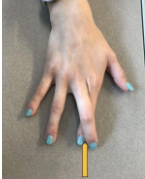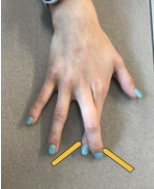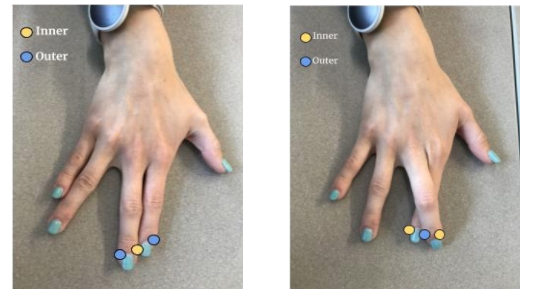Written by Taylor Carlson, Elizabeth Johnson, Marie Osuna, Katie Rhoten, and Madison Sinclair
Tactile illusions refer to sensations that affect your sense of touch. For example, if you are wearing rubber gloves while doing dishes, you may feel as if your hands are wet! This sensation might feel odd, but you aren’t crazy for feeling this way! Another tactile illusion, and one of the oldest known, is the Aristotle Illusion, yet it’s probably something that you haven’t experienced in your everyday life. And why is that? Simply because most of us do not walk around with our fingers crossed. With a pencil, a partner, and a minute to spare you can experience it for yourself.
 Here’s how the illusion works: cross your middle finger over your pointer finger and close your eyes. Have a friend use a pencil to gently touch the “V” shaped area created between the crossed fingers. Do you feel as if you are being touched by one or two things? Most people feel two. If you are alone, you may also try crossing your fingers and reaching up to touch your nose. With the crossed fingers, you’ll feel as if you are touching two noses!
Here’s how the illusion works: cross your middle finger over your pointer finger and close your eyes. Have a friend use a pencil to gently touch the “V” shaped area created between the crossed fingers. Do you feel as if you are being touched by one or two things? Most people feel two. If you are alone, you may also try crossing your fingers and reaching up to touch your nose. With the crossed fingers, you’ll feel as if you are touching two noses!
 The reverse of this effect may also occur in which you perceive two objects as one. While your fingers are crossed, have someone take two pencils and at the same time touch one on each exposed side of your fingers, you may feel as if it is only one object.
The reverse of this effect may also occur in which you perceive two objects as one. While your fingers are crossed, have someone take two pencils and at the same time touch one on each exposed side of your fingers, you may feel as if it is only one object.
But why do we feel two pencils between our crossed fingers when there’s actually only one present? The illusion happens because your fingers are crossed in such a way that the insides of two fingers that usually touch are now facing away from each other. Since your brain is used to these fingers responding to the same stimulus when their position is changed it feels as if only one pencil is touching your fingers when it is actually two!
Note the distance between the two outer sides of each finger on the uncrossed hand. Typically, if the two outer sides of the uncrossed fingers are stimulated it is because they are coming into contact with two different stimuli, such as two pencils, and these signals of touch sensations are sent to different areas of the brain. Therefore, we perceive sensations of touch on both the inner and outer areas of the fingers regardless of if the fingers are crossed or uncrossed since the sensory signals are not converging and are processed separately. When the fingers are crossed and there is only one pencil between them, the brain still processes the touch signals as coming from two different locations as both outer regions are stimulated, thus it ultimately perceives two pencils instead of one.
The Aristotle illusion allows us to see that a simple action, such as crossing your fingers, has the power to trick your mind into interpreting sensations differently. While we can usually trust our perceptions, it’s important to be aware that your body can fool you!
References
Aristotle’s Illusion. (n.d.). Retrieved from https://www.illusionsindex.org/i/aristotle
Aristotle’s illusion in focal hand dystonia • Body in Mind. (2013, August 6). Retrieved from https://bodyinmind.org/aristotle-illusion-in-focal-hand-dystonia/
